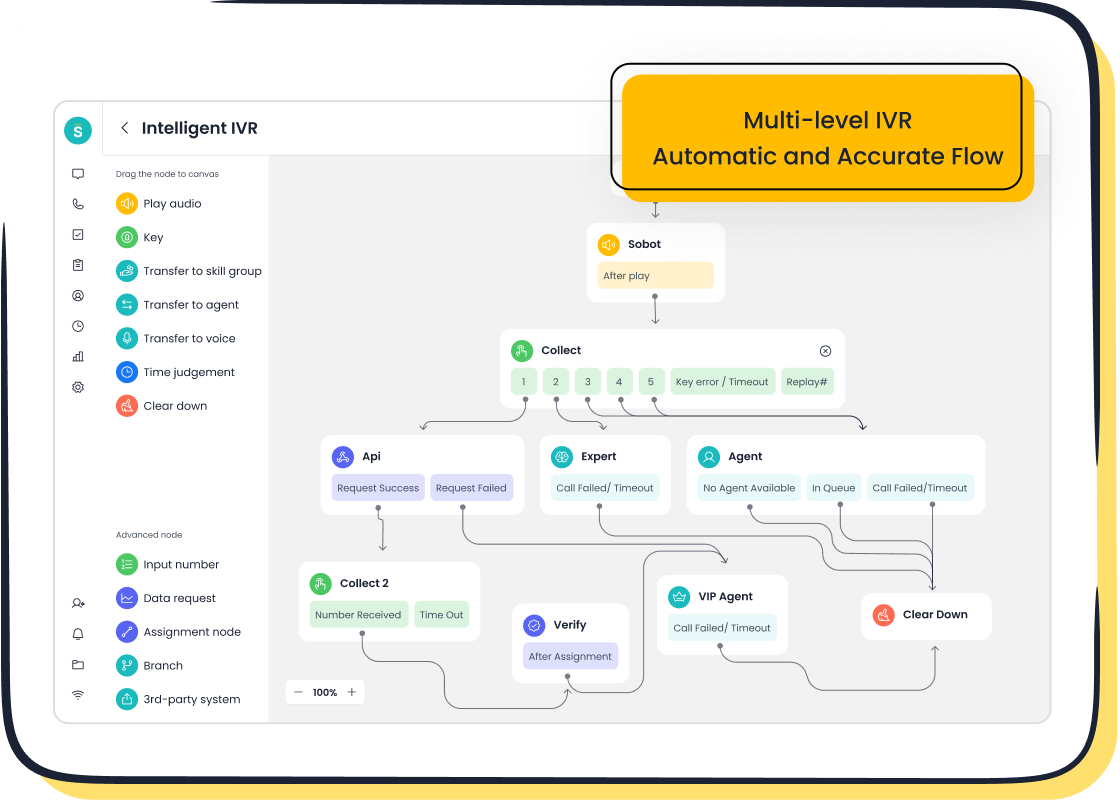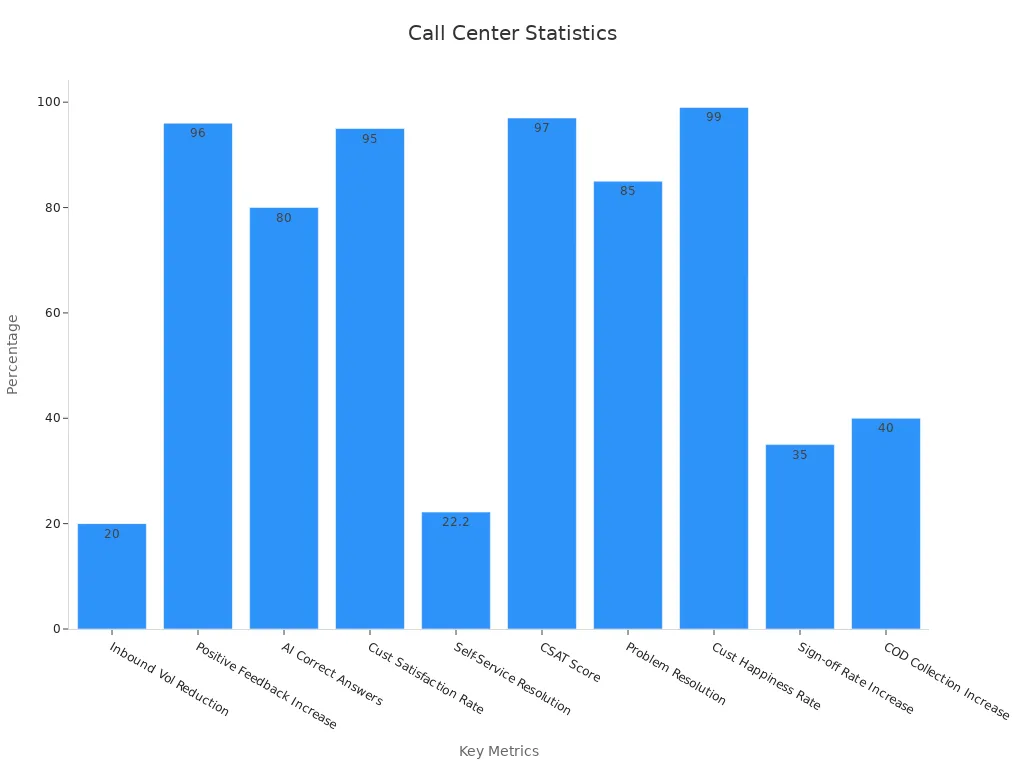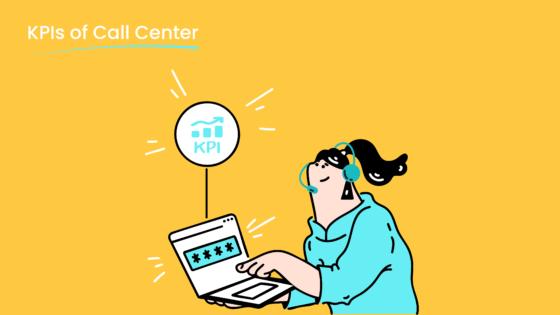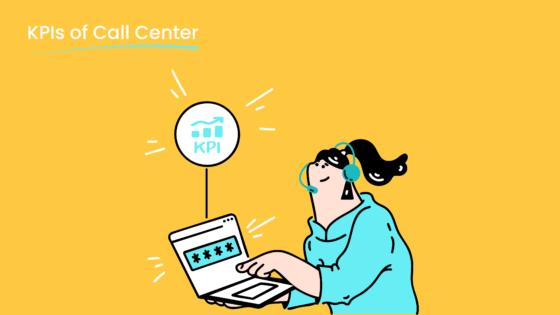How to Create an Efficient Inbound Call Center Platform

In today’s fast-paced world, delivering exceptional customer service is critical for any business. An efficient inbound call center platform ensures you meet customer expectations while staying ahead of the competition. Recent statistics show that 65% of customers expect immediate responses, and 76% feel frustrated when support lacks personalization. These numbers highlight the importance of creating seamless and tailored interactions.
Technology plays a transformative role in modern call centers. With AI projected to drive 95% of customer interactions by 2025, businesses can leverage tools like Sobot's Voice/Call Center to optimize operations. Sobot integrates intelligent IVR, smart call routing, and real-time analytics to enhance efficiency and satisfaction. By adopting such solutions, you can improve customer trust and loyalty while reducing operational costs.
Define the Purpose and Benefits of an Inbound Call Center
Understanding the role of an inbound call center in customer service.
An inbound call center serves as the backbone of customer communication. It handles incoming calls from customers seeking support, information, or solutions. By acting as the first point of contact, it shapes the customer experience and builds trust. Research shows that 95% of contact center professionals prioritize customer satisfaction as the most critical metric. Additionally, 87% of consumers expect proactive service when they reach out, emphasizing the importance of understanding customer needs and delivering personalized interactions.

Inbound call centers also provide valuable insights. For example, 82% of organizations uncover costly blind spots through inbound calls. These insights help businesses refine their strategies and improve operations. By leveraging advanced tools like Sobot's inbound call center platform, you can streamline customer communication and ensure every interaction adds value.
| Statistic | Description |
|---|---|
| 95% | Contact center professionals consider customer satisfaction as the most important metric. |
| 87% | Consumers expect proactive customer service when they call. |
| 82% | Insights from inbound calls can reveal costly blind spots in organizations. |
Key benefits: improved customer satisfaction, faster resolution times, and enhanced brand loyalty.
An efficient inbound call center platform offers several benefits that directly impact your business. First, it improves customer satisfaction by addressing inquiries promptly and accurately. Satisfied customers are more likely to return, refer others, and leave positive reviews, boosting customer retention. Second, faster resolution times enhance the overall customer experience. Metrics like Average Resolution Time (ART) track how quickly issues are resolved. Lower ART scores lead to higher satisfaction rates, which strengthen brand loyalty.
Finally, an inbound call center fosters long-term relationships. When customers feel valued and understood, they develop a deeper connection with your brand. This connection translates into repeat business and advocacy. For example, Invoca's analysis reduced unwanted inbound calls by 20%, allowing agents to focus on high-value interactions. Similarly, a financial institution improved efficiency by two-thirds after optimizing call routing.
How Sobot's inbound call center platform supports diverse industries.
Sobot's inbound call center platform empowers businesses across various industries to deliver exceptional service. Its intelligent IVR system ensures calls are routed to the right agents, reducing wait times and improving resolution rates. Features like AI-powered Voicebot and unified workspaces enable agents to handle inquiries efficiently, even during peak hours.

For instance, Weee!, an online Asian supermarket, achieved remarkable results with Sobot's platform. By implementing flexible IVR and multilingual support, Weee! increased agent efficiency by 20% and reduced resolution time by 50%. The customer satisfaction score soared to 96%, showcasing the platform's ability to meet diverse needs. Other industries, such as financial services and gaming, benefit from Sobot's solutions by enhancing customer happiness rates and achieving up to 99% satisfaction.

Sobot's platform combines innovation and reliability, making it a trusted choice for businesses aiming to improve customer communication and retention.
Step-by-Step Guide to Implementing an Inbound Call Center Platform
Establish clear goals and objectives for your call center.
Setting clear goals is the foundation of an efficient call center. Without well-defined objectives, your team may struggle to prioritize tasks or measure success. Using the S.M.A.R.T framework—Specific, Measurable, Achievable, Realistic, and Time-Bound—ensures your goals are actionable and aligned with your business needs. For example, you might aim to reduce average handle time (AHT) by 15% within six months or achieve a 90% first-call resolution rate by the end of the quarter.
Encourage your team to set individual goals as well. When agents take ownership of their targets, they feel more engaged and accountable. Management plays a crucial role here by guiding agents and providing regular feedback. Clear objectives also help you identify areas for improvement, whether it’s enhancing call routing or refining customer service scripts. By focusing on these goals, you create a roadmap for success that benefits both your team and your customers.
Tip: Prioritize customer-centric goals, such as improving satisfaction scores or reducing wait times, to enhance the overall experience for inbound calls.
Determine the budget and allocate resources effectively.
Budgeting is a critical step in implementing a call center platform. Start by assessing your financial resources and setting a realistic budget based on your revenue projections. Industry benchmarks can guide you in allocating funds efficiently. For instance, the Cost Per Call (CPC) metric measures the average cost of handling each call, helping you plan for capacity and resource needs.
- Evaluate Costs: Consider expenses like software subscriptions, hardware, training, and staffing.
- Distribute Resources: Allocate funds across essential areas, such as technology, agent training, and customer support tools.
- Monitor Performance: Regularly track key performance indicators (KPIs) like CPC to ensure your spending aligns with your goals.
| Metric | Description |
|---|---|
| Cost Per Call (CPC) | Measures the average cost incurred by a call center to handle each phone call, aiding in budgeting and capacity planning. |
Tracking CPC over time reveals the financial efficiency of your operations. For example, if your CPC decreases after implementing Sobot's Voice/Call Center, it indicates improved cost management and operational efficiency. By continuously monitoring and optimizing your budget, you ensure that your resources are used effectively to support your call center's objectives.
Select the right technology, including Sobot's Voice/Call Center.

Choosing the right technology is pivotal to the success of your inbound call center platform. Advanced tools streamline operations, improve efficiency, and enhance customer satisfaction. Sobot's Voice/Call Center offers a comprehensive solution with features like intelligent IVR, AI-powered Voicebot, and real-time analytics. These tools enable you to handle inbound calls more effectively while reducing operational complexity.
| Feature/Benefit | Description |
|---|---|
| Global Coverage | Extensive phone number coverage worldwide through partners like Twilio, Vonage, and Infobip. |
| Efficient Task Assignment | Assigns tasks to suitable skill groups, maximizing productivity and enhancing telemarketing quality. |
| Real-time Call Monitoring | Enables supervisors to monitor calls, track KPIs, and gather insights during the outbound process. |
| CRM Integration | Seamless integration with CRM systems like Salesforce or HubSpot, streamlining processes and saving time. |
For example, Sobot's intelligent IVR system routes calls to the most qualified agents, reducing wait times and improving resolution rates. Its AI-powered Voicebot handles repetitive queries, freeing up agents to focus on complex issues. Additionally, the platform's global number availability ensures you can support customers across different regions without interruptions.
When selecting a platform, prioritize features that align with your business goals. Look for tools that integrate seamlessly with your existing systems and offer scalability as your operations grow. Sobot's Voice/Call Center checks all these boxes, making it an ideal choice for businesses aiming to enhance their call center efficiency.
Note: Investing in the right technology not only improves customer satisfaction but also boosts agent productivity, creating a win-win scenario for your business.
Set up a virtual call center with global accessibility.
Setting up a virtual call center with global accessibility allows businesses to connect with customers across different regions without geographical limitations. Virtual call centers operate entirely online, enabling agents to work remotely while maintaining high levels of efficiency and customer satisfaction. To ensure success, you need to focus on accessibility, scalability, and technology integration.
Key Steps to Set Up a Virtual Call Center:
- Choose Reliable Software: Select a platform that supports global operations and offers features like intelligent IVR, smart call routing, and real-time analytics. Sobot's Voice/Call Center provides these capabilities, ensuring seamless communication across borders.
- Ensure Accessibility: Partner with software vendors that prioritize accessibility for employees with disabilities. Services like Microsoft Disability Answer Desk and Apple Accessibility Support can help you create an inclusive environment.
- Train for Accessibility: Educate your team on making virtual meetings accessible. Provide instructions on creating accessible content and remind participants of best practices during meetings.
- Secure Global Numbers: Use a platform that offers global number availability. Sobot's solution ensures you can acquire phone numbers worldwide, enabling you to support inbound calls from diverse regions.
- Optimize Time Zones: Configure your system to accommodate time zone differences. Sobot's time zone support allows you to collect and analyze data based on customer locations, ensuring timely responses.
Virtual call centers also reduce operational costs. By eliminating the need for physical infrastructure, you can allocate resources to technology and training. For example, businesses using virtual call centers report a 30% increase in productivity due to streamlined workflows and remote accessibility.
Tip: Regularly test your platform for reliability and scalability. This ensures your virtual call center can handle peak call volumes without interruptions.
Train your team to deliver exceptional customer service.
Training your team is essential for delivering exceptional customer service. Well-trained agents handle inquiries efficiently, resolve issues faster, and create positive experiences for customers. To maximize the impact of training, focus on skill development, performance metrics, and continuous learning.
Metrics That Reflect Training Success:
| Metric | Description |
|---|---|
| Customer Satisfaction Scores | Higher scores indicate that trained employees are providing better customer experiences. |
| Employee Turnover Rate | Lower turnover rates suggest effective training programs that engage and develop employees. |
| Return on Investment (ROI) | Evaluates the financial benefits of training by comparing costs with resulting benefits like productivity gains. |
| Impact on Key Performance Indicators (KPIs) | Measures the influence of training on critical business outcomes like sales revenue and customer satisfaction. |
Steps to Train Your Team:
- Develop Comprehensive Training Modules: Create modules that cover essential skills like communication, problem-solving, and product knowledge. Include role-playing exercises to simulate real-world scenarios.
- Leverage Technology: Use tools like Sobot's unified workspace to provide agents with access to customer data and call analytics. This helps them make informed decisions during interactions.
- Monitor Progress: Track metrics like customer satisfaction scores and first-call resolution rates to evaluate training effectiveness. Adjust your program based on these insights.
- Encourage Continuous Learning: Offer ongoing workshops and certifications to keep your team updated on industry trends and best practices.
For example, companies that invest in training see a 20% improvement in customer satisfaction scores and a 15% reduction in employee turnover rates. These results highlight the importance of equipping your team with the skills they need to excel.
Note: Recognize and reward top-performing agents to motivate your team and foster a culture of excellence.
Choosing the Right Technology for Your Call Center

Features to look for: IVR, CRM integration, and analytics.
When you choose a center platform for your call center, focusing on advanced call center features is essential. These features not only improve efficiency but also enhance the overall customer experience. Three critical features to prioritize are IVR, CRM integration, and analytics.
- IVR (Interactive Voice Response): IVR systems allow you to automate call routing, ensuring customers reach the right agent quickly. This reduces wait times and improves customer satisfaction. For example, Sobot's intelligent IVR lets you customize greetings, build menus, and route calls seamlessly using a drag-and-drop interface.
- CRM Integration: Connecting your call center software with CRM tools enables agents to access customer information instantly. This integration ensures personalized service by recognizing returning customers and tailoring responses based on their history.
- Analytics: Real-time monitoring and call reporting provide valuable insights into your operations. These tools help you track performance metrics like average handling time and customer satisfaction scores, allowing you to make data-driven decisions.
| Feature | Description |
|---|---|
| Real-time Monitoring | Allows managers to track performance metrics as they happen for quick decision-making. |
| CRM Integration | Connects customer information with contact center data, enhancing service quality for agents. |
| Call Reporting | Provides insights into operations, helping analyze patterns and optimize performance. |
By focusing on these features, you can create a cloud-based call center that meets modern customer expectations and drives operational success.
How Sobot's Voice/Call Center ensures seamless operations.
Sobot's Voice/Call Center stands out as a reliable solution for businesses aiming to improve call center efficiency. Its advanced call center features ensure smooth operations and exceptional customer experiences.
- Optimized KPIs: Sobot helps you measure and improve key performance indicators like average handling time and first-call resolution rates. These metrics directly impact customer satisfaction and operational efficiency.
- Global Accessibility: With global number availability and time zone support, Sobot ensures you can serve customers worldwide without interruptions.
- Unified Workspace: Agents benefit from a centralized platform that consolidates customer data and communication channels, reducing complexity and improving productivity.
- AI-Powered Tools: Sobot's Voicebot handles repetitive queries, freeing agents to focus on more complex issues. This automation enhances both speed and accuracy in customer interactions.
For example, Weee!, an online Asian supermarket, used Sobot's platform to achieve a 20% increase in agent efficiency and a 50% reduction in resolution time. These results highlight how Sobot's technology ensures seamless operations while delivering measurable outcomes.
Leveraging AI-powered tools for automation and efficiency.
AI-powered tools have revolutionized the way call centers operate. By automating repetitive tasks, these tools allow agents to focus on delivering personalized service, improving both efficiency and customer satisfaction.
- Automation: AI tools handle common queries autonomously, reducing the need for human intervention. For instance, Sobot's AI-powered Voicebot recognizes customer intent and provides instant responses, ensuring faster resolutions.
- Personalization: AI identifies returning customers and tailors interactions based on their previous inquiries. This creates a more engaging and satisfying customer experience.
- Integration: AI seamlessly integrates with CRM systems and databases, providing agents with accurate information during calls. This reduces errors and enhances service quality.
Businesses that adopt AI-powered tools report significant improvements in productivity and customer satisfaction. Sobot's Voice/Call Center leverages AI to streamline workflows, optimize resource allocation, and deliver consistent results. By incorporating these tools, you can transform your call center into a high-performing, customer-centric operation.
Tip: Regularly update your AI tools to keep up with evolving customer needs and technological advancements.
Best Practices for Setting Up a Virtual Call Center

Designing workflows that align with business goals.
Creating workflows that reflect your business goals is essential to improve your virtual call center. Start by identifying key objectives, such as reducing customer wait times or increasing first-call resolution rates. Then, design processes that support these goals. For example, a telecommunications company aligned its workflows across in-store, online, and call center interactions. This consistency reduced customer frustration and churn. Similarly, an e-commerce platform adjusted workflows during the holiday season to adapt to changing customer behaviors, optimizing the shopping experience.
To measure success, use metrics like Net Promoter Score (NPS) to gauge customer loyalty. A software company used NPS to identify areas for improvement, ensuring workflows met customer expectations. By aligning workflows with your goals, you create a seamless experience that enhances customer satisfaction and operational efficiency.
Tip: Regularly review and refine workflows to adapt to evolving customer needs and business priorities.
Configuring and testing the platform for reliability.
Testing your platform ensures your virtual call center operates smoothly. Begin by verifying core functions like call routing and transfers. This step ensures customers connect with the right agents without delays. Next, test for potential issues such as poor audio quality or dropped calls. Identifying these problems early prevents disruptions during live operations.
Advanced features like Sobot's intelligent IVR and AI-powered Voicebot should also undergo rigorous testing. These tools streamline workflows and enhance customer interactions. For example, businesses that prioritize platform reliability report significant benefits:
| Statistic | Description |
|---|---|
| 86% | Clients willing to pay more for great customer service. |
| 93% | Customers likely to make repeat purchases due to excellent service. |
| 89% | Clients switching to competitors due to poor service. |
Testing ensures your platform meets these high standards, helping you retain customers and build loyalty.
Ensuring data security and compliance with Sobot's solutions.
Data security is critical when starting a virtual call center. Customers trust you with sensitive information, so protecting it should be a top priority. Use platforms like Sobot's Voice/Call Center, which offers encrypted data transfer and complies with global security standards. This ensures customer data remains safe during interactions.
Additionally, train your team on data privacy best practices. Educate them about handling sensitive information and recognizing potential security threats. Regular audits and updates to your system further enhance security. By prioritizing compliance and security, you build trust with your customers and protect your business from potential risks.
Note: Sobot's solutions provide a secure foundation for virtual call centers, ensuring compliance with industry regulations while maintaining high system uptime.
Maintaining and Optimizing Call Center Efficiency
Monitoring KPIs like average handle time and first-call resolution.
Tracking key performance indicators (KPIs) is essential for maintaining the efficiency of your call center. Metrics like average handle time (AHT) and first-call resolution (FCR) provide valuable insights into your operations. AHT measures the average time agents take to resolve customer inquiries, while FCR tracks the percentage of issues resolved during the first interaction. These metrics directly impact customer satisfaction and the overall customer experience.
To monitor these KPIs effectively:
- List your objectives to align metrics with your business goals.
- Assess current performance to identify areas for improvement.
- Select financial and non-financial KPIs to track.
- Use sophisticated software like Sobot's analytics tools for real-time tracking.
| KPI | Definition | Industry Relevance |
|---|---|---|
| First Call Resolution | Measures the ability to resolve customer issues on the first interaction | Healthcare, Law, Finance, Non-profit |
| Average Handle Time | Average time taken to resolve a customer inquiry | Law, Finance, Education |
For example, world-class FCR rates exceed 80%, achieved by only 5% of call centers. The average AHT across industries is 697 seconds. By improving these metrics, you enhance customer satisfaction and operational efficiency.

Using Sobot's analytics tools for performance insights.
Sobot's analytics tools empower you to optimize call center operations by providing actionable insights. These tools track KPIs like AHT and FCR in real time, enabling you to identify trends and areas for improvement. Supervisors can monitor call data, analyze patterns, and adjust workflows to enhance efficiency.
For instance, Sobot's unified workspace consolidates customer data and communication channels, reducing complexity for agents. Its AI-powered Voicebot handles repetitive queries, freeing agents to focus on complex issues. These features improve resolution rates and reduce average handling time. Businesses using Sobot's platform report higher customer satisfaction scores and greater productivity.
By leveraging Sobot's analytics tools, you gain a clear understanding of your call center's performance. This data-driven approach helps you make informed decisions, ensuring your operations remain efficient and customer-focused.
Fostering a culture of continuous improvement and collaboration.
Creating a collaborative culture in your call center drives continuous improvement and enhances customer satisfaction. When agents work together and share knowledge, they resolve issues faster and deliver better customer experiences. Collaboration also reduces errors and lowers operating costs.
To foster this culture:
- Define a clear vision of customer needs.
- Encourage self-reflection among agents to identify areas for growth.
- Provide regular training and feedback to improve performance.
Call centers that prioritize collaboration see higher levels of customer loyalty and retention. For example, businesses adopting this approach report fewer errors and improved efficiency. Sobot supports this culture by offering tools like unified workspaces and performance analytics, which streamline communication and promote teamwork.
By focusing on collaboration and continuous improvement, you create an environment where agents thrive and customers feel valued.
An efficient inbound call center platform is essential for delivering exceptional customer service and driving business success. Metrics like first call resolution and average handle time demonstrate how streamlined operations improve customer satisfaction and loyalty. For example, lower average time in queue enhances customer experience, while faster response times boost agent productivity. These factors collectively ensure operational excellence.
Sobot's Voice/Call Center empowers businesses to achieve these results. Its intelligent IVR, AI-powered tools, and global accessibility enable seamless communication with customers. Real-time analytics and unified workspaces further enhance efficiency, ensuring your call center meets modern demands. Companies like Weee! have already experienced significant improvements, such as a 20% increase in agent efficiency.
Take the first step toward transforming your call center. Define clear goals, invest in the right technology, and train your team to deliver exceptional service. With Sobot's solutions, you can create a customer-centric operation that drives long-term success.
FAQ
What is an inbound call center platform?
An inbound call center platform manages incoming customer calls. It routes calls to the right agents, tracks performance metrics, and enhances customer service. Tools like Sobot's Voice/Call Center include intelligent IVR and real-time analytics, ensuring efficient operations and improved customer satisfaction.
How does Sobot's platform improve call center efficiency?
Sobot's platform uses features like AI-powered Voicebot, smart call routing, and unified workspaces. These tools reduce average handle time and increase first-call resolution rates. For example, Weee! achieved a 20% boost in agent efficiency using Sobot's inbound call center platform.
Can small businesses benefit from an inbound call center platform?
Yes, small businesses can use inbound call center platforms to handle customer inquiries efficiently. Sobot's scalable solutions, like its economic SaaS rental model, make advanced features accessible to businesses of all sizes, improving customer satisfaction and operational efficiency.
How does AI enhance inbound call center platforms?
AI automates repetitive tasks, recognizes customer intent, and provides instant responses. Sobot's AI-powered Voicebot handles common queries, freeing agents to focus on complex issues. This improves resolution times and ensures personalized customer experiences.
Is Sobot's inbound call center platform secure?
Yes, Sobot ensures data security with encrypted data transfer and compliance with global standards. Its 99.99% system uptime guarantees reliable operations, making it a trusted choice for businesses prioritizing customer data protection.
See Also
Understanding The Efficiency Of Call Center Automation
A Comprehensive Guide To Omnichannel Contact Center Setup
Essential Characteristics Of CRM Software For Call Centers
Navigating The World Of Omnichannel Call Center Tools
Best Practices For Effective Quality Management In Call Centers